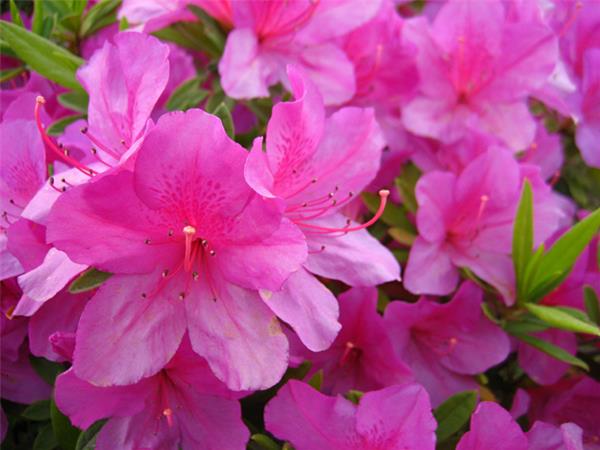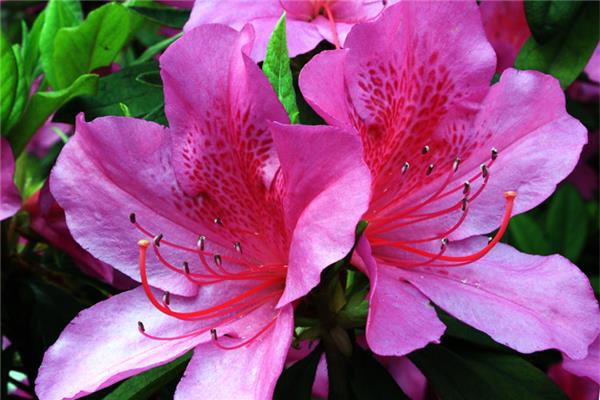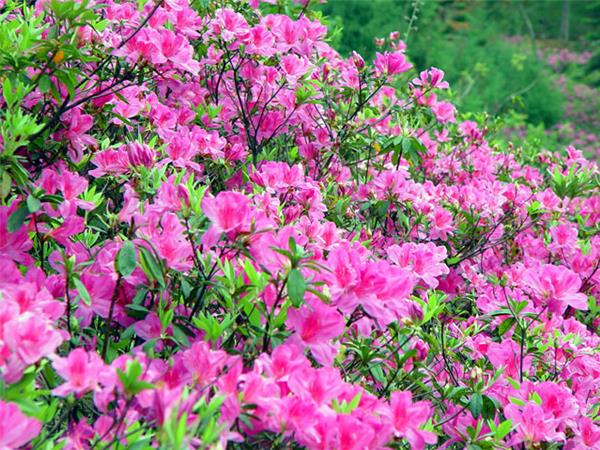The difference between rhododendron and spring cuckoo breeding and garden use of rhododendron
Cuckoo is a kind of plant with very good ornamental effect. Planting Cuckoo in batches can form a very gorgeous flower landscape. It is a very suitable plant for decorating gardens, courtyards, terraces and other places.

1. The difference between Mao Juan and Spring Juan
Mao Juan: alias brocade rhododendron, evergreen or semi-evergreen shrub, up to 3m, branches sparse, young branches densely pale brown flat hairs, leaves papery, dimorphic, elliptic to elliptic lanceolate or rectangular oblanceolate, 2.5~ 5.6 cm long, 8~18mm wide, sharp tip, convex tip, base wedge, scattered yellow sparse hairs at the beginning, later nearly glabrous, tip blunt, base wedge, margin with eyelashes, petiole hairy, petiole 4~6mm long, leaf surface, Back hair and midvein for many, autumn leaves narrow obovate or elliptic lanceolate, thick and shiny. Capsule oblong-ovate, ca. 8mm, hispid and persistent calyx. Traditional varieties are "jade butterfly","purple butterfly","Ryukyu red","jade bell" and so on.
Spring azalea: also known as rhododendron, pomegranate, deciduous shrub, about 2 meters high; many branches, thin and straight branches. Leaves alternate, long elliptic-ovate, apex pointed, surface dark green, sparsely stiff hairy, abaxially pale green. Racemes, flowers solitary or terminal, funnel-shaped, colorful, varied. There are evergreen cuckoo, deciduous cuckoo; according to the flowering period is divided into spring cuckoo, summer cuckoo and spring cuckoo. According to flower type, it is divided into single petal, sleeve petal and double petal. Petals and flat, slightly wrinkled edge and wrinkled edge of the points. The flowering period is from April to May and the fruiting period is October. More than born in hillside, hilly thickets.

2. Ecological Habits of Cuckoo
Cuckoos prefer cool, moist and sunny environments. Cold tolerance, fear of heat, resistance to semi-shade, not resistant to long-term exposure to strong light. The optimum temperature for growth is 15~28℃, and the low temperature of-8℃ can be tolerated in winter. Fertile, loose, well-drained acidic sandy loam soil is appropriate.
3. Breeding skills of hairy cuckoo
1. Plugging: carried out during the rainy season. Select semi-mature shoots, 12~15 cm long, remove 2~3 leaves at the base, leave the top leaves and cut off half. Cuttings were treated with 0.8% IBA solution for 2~3 seconds, inserted into sand bed, kept at 15~18℃, and rooted 50~60 days after insertion.
2. Layering: in April to May, with high-altitude layering method. Select 2~3 years old mature branches, in the top 20~30 cm from the branch line ring peeling, 2 cm wide, with decaying soil and film wrapped. 4~5 months to heal root, autumn cut potted.
3. Sowing: April is appropriate, indoor pot sowing. The optimum temperature for germination is 22~24℃, germination occurs 10~15 days after sowing, and seedling growth is slow.

4. Control of diseases and insect pests of Cuckoo
Brown mold and black spot often occur in cuckoo. 70% mancozeb WP 600 times solution was sprayed. Insect pests are red spider and military pests harm, with 80% dichlorvos EC 1000 times spray kill.
5. Garden Use of Cuckoo
The cuckoo is planted in pieces, and the flowers are blooming like brocade, which can increase the natural landscape effect of the garden. Can also be planted next to rocks, poolside, lawn edge, add garden atmosphere. Potted plants are placed in hotels, rooms and public places, and they are gorgeous.

Well, that's all about the cuckoo. After reading the above introduction, do you also have an interest in breeding this plant with brilliant flowers and beautiful flowers? If so, don't hesitate to decorate your home with it.
Related
- Wuhan Hospital Iron Tree Blooming Result Was Instantly Frightened by the Gardener Master
- Which variety of camellia is the most fragrant and best? Which one do you like best?
- What is the small blue coat, the breeding methods and matters needing attention of the succulent plant
- Dormancy time and maintenance management of succulent plants during dormancy
- Minas succulent how to raise, Minas succulent plant pictures
- What are the varieties of winter succulent plants
- How to raise succulent plants in twelve rolls? let's take a look at some experience of breeding twelve rolls.
- Attention should be paid to water control for succulent plants during dormant period (winter and summer)
- Watering experience of twelve rolls of succulent plants
- Techniques for fertilizing succulent plants. An article will let you know how to fertilize succulent plants.



